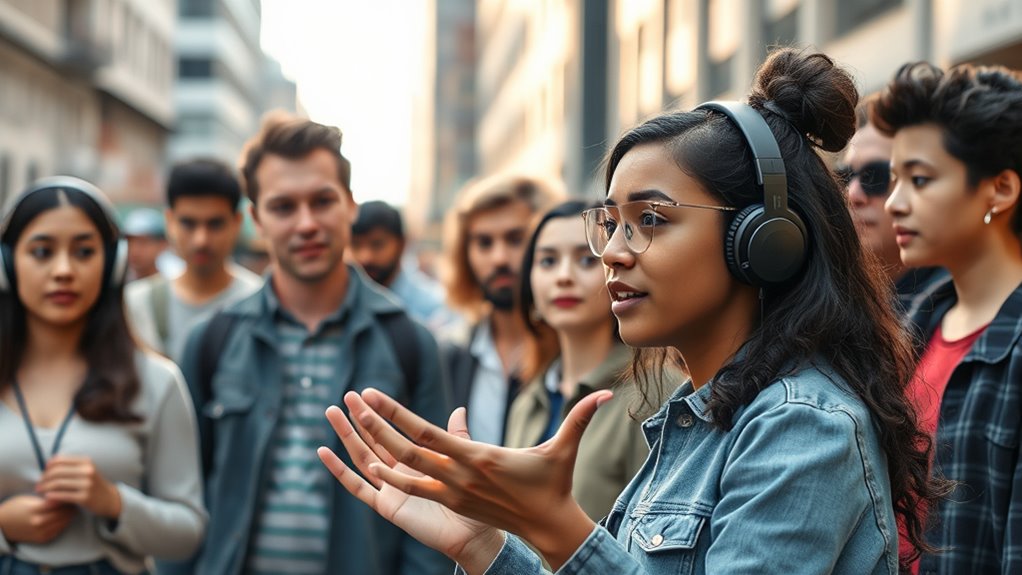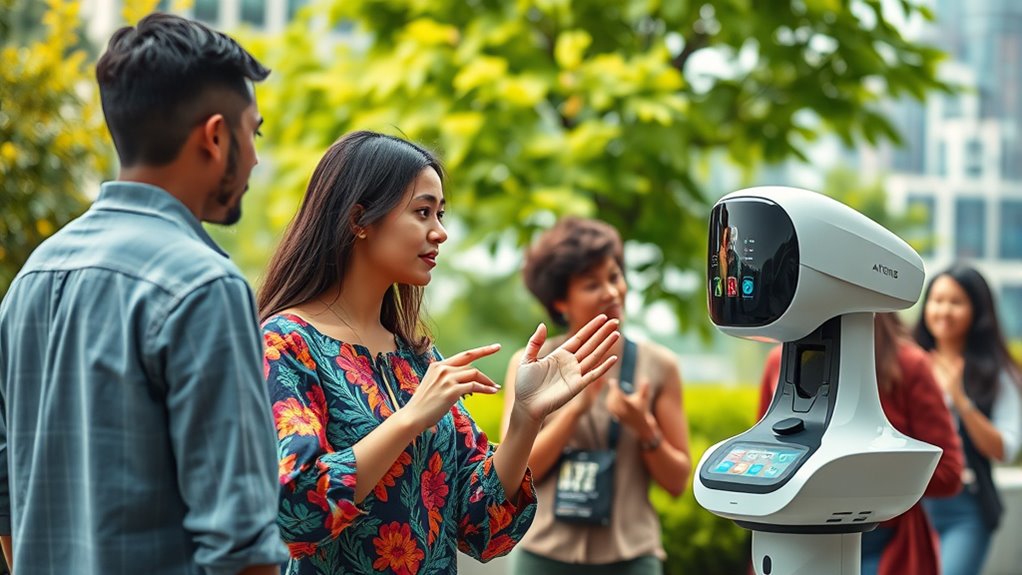AI now helps break language barriers by instantly translating sign languages into spoken languages, making communication more accessible for deaf communities worldwide. Through advanced technologies like deep learning and gesture recognition, AI systems understand hand movements, facial expressions, and body language. They can adapt to regional dialects and cultural nuances, fostering more authentic interactions. As these innovations progress, you’ll discover how AI is transforming inclusive communication and bridging cultural divides—stay tuned for the full picture.
Key Takeaways
- AI uses advanced gesture recognition and machine learning to translate sign language into spoken languages instantly.
- Multilingual AI systems accommodate regional dialects and diverse sign languages for accurate cross-lingual communication.
- Real-time translation tools with depth sensors and facial analysis bridge the communication gap between deaf and hearing communities.
- Enhanced data resources and synthetic data generation improve AI accuracy across various sign language styles.
- Privacy and cultural considerations ensure respectful, secure, and culturally sensitive sign language translation solutions.
The Evolution of Sign Language Recognition Technologies

The evolution of sign language recognition technologies has rapidly transformed how you bridge communication gaps for the deaf community. Early systems focused mainly on basic gestures, but now, advancements enable machines to understand complex sign language syntax. Recognizing the structure and grammar of sign language helps improve translation accuracy, making interactions more natural. Additionally, these technologies account for cultural sign variations, which differ across regions and communities. By adapting to diverse signing styles, AI-driven tools become more inclusive and effective. Over time, innovations like depth sensors and machine learning algorithms have enhanced recognition capabilities, allowing devices to interpret subtle facial expressions and body movements. This progress paves the way for seamless communication, respecting the rich diversity within sign language communities worldwide. Moreover, understanding the significance of cultural narratives in sign language can further refine these technologies to better serve different communities.
How AI Facilitates Real-Time Sign Language Translation

Artificial intelligence accelerates sign language translation by enabling devices to interpret gestures instantly. This real-time accuracy is vital for effective communication, especially in urgent or dynamic situations. AI-driven systems analyze hand movements, facial expressions, and body language to deliver immediate translations, reducing delays that previously hindered smooth conversations. By addressing multilingual challenges, AI models can recognize diverse sign languages and dialects, ensuring broader accessibility. Advanced algorithms process visual data quickly, providing near-instant results that allow users to interact seamlessly. This technology bridges gaps between sign language users and spoken language speakers, fostering inclusivity. As AI continues to improve, real-time sign language translation becomes more reliable, making conversations more natural and efficient for everyone involved. Additionally, ongoing AI safety research helps mitigate vulnerabilities, ensuring these translation systems operate securely and accurately. Incorporating machine learning techniques further enhances system adaptability to new signs and dialects, making the technology increasingly versatile and culturally inclusive. Furthermore, improvements in visual recognition contribute to higher translation accuracy across various environments and lighting conditions, which is essential for effective communication in diverse settings.
Overcoming Challenges in Sign Language Processing

You’ll face challenges like accurately recognizing gestures and understanding context, which are vital for reliable translation. Limited data resources also make it harder to train effective AI models for diverse sign languages. Additionally, sound healing science research indicates that leveraging specific frequencies and vibrations could inform new approaches to interpretative gestures more accurately, highlighting the importance of multidisciplinary strategies. Exploring celebrity transformations can inspire innovative designs for gesture recognition systems by examining how visual cues are adapted and perceived. Moreover, understanding emotional support principles can help in designing more empathetic AI systems that better interpret user emotions and intentions. Overcoming these hurdles requires innovative solutions and ongoing research to improve sign language processing. Developing best beaches information can serve as a model for creating comprehensive, accessible datasets that enhance AI understanding across different languages. Moreover, understanding retirement planning principles can help in designing sustainable long-term solutions for data collection and model training that adapt over time.
Gesture Recognition Difficulties
Recognizing sign language gestures with accuracy remains a significant challenge due to their complex, dynamic nature. Gesture ambiguity often causes confusion, as different signs can look similar, making it hard for AI systems to distinguish between them. Additionally, sensor limitations hinder precise capture of rapid finger movements and subtle hand shifts, reducing recognition accuracy. You might find that even slight variations in hand position or movement speed can lead to misinterpretation. These issues are compounded when lighting conditions or camera angles are less than ideal. Overcoming these difficulties requires advanced algorithms and better sensor technology. By addressing gesture ambiguity and sensor limitations, AI can become more reliable in interpreting sign language, bringing us closer to seamless, inclusive communication.
Contextual Sign Interpretation
Understanding sign language accurately requires more than just recognizing individual gestures; it demands interpreting them within their broader context. Contextual sign interpretation involves detecting cues that clarify meaning, such as facial expressions, body posture, and surrounding gestures. These contextual cues help you grasp the speaker’s intent and emotional tone. To improve this process, focus on:
- Recognizing linguistic nuances that influence gesture meaning.
- Integrating facial expressions as key contextual cues.
- Developing AI models that adapt to different sign language dialects and environments.
- Considering contextual cues like environmental factors and conversation setting to further refine interpretation accuracy, which can be supported by analyzing multimodal signals to better understand complex interactions. Additionally, advancements in vetted AI technologies ensure more reliable and precise translations across diverse sign languages. Incorporating personality traits can also enhance AI’s ability to interpret nuanced emotional expressions in sign language communication. Recognizing AI security measures in these systems is essential to protect sensitive communication data.
Limited Data Resources
While integrating contextual cues improves sign language interpretation, a major obstacle remains: limited data resources. Data scarcity hampers AI models from learning diverse signs and expressions, constraining accuracy. Resource limitations mean fewer annotated datasets, reducing the AI’s ability to generalize across different sign languages and contexts. To address this, researchers explore data augmentation, synthetic data generation, and transfer learning. These methods help bridge the gap caused by scarce data. Additionally, incorporating Organic and Natural Juices techniques can inspire innovative ways to generate and enhance sign language datasets through naturalistic and varied sign recordings. Leveraging regional legal resources and community input can also aid in collecting more diverse data. Moreover, ensuring standardized data formats can facilitate interoperability and more effective training across different datasets. Ensuring user privacy and responsible data handling remains critical as these methods evolve. Developing comprehensive data collection strategies that respect privacy and cultural differences is essential for advancing sign language AI.
The Role of Deep Learning in Understanding Sign Languages

Deep learning has revolutionized how we interpret sign languages by enabling computers to analyze complex visual gestures with remarkable accuracy. Neural networks play a key role, learning patterns directly from video data. They excel at feature extraction, identifying critical movements and hand shapes that define each sign. To understand how deep learning advances sign language recognition, consider these points:
- Neural networks process vast amounts of visual data, improving recognition speed and precision.
- Automated feature extraction eliminates manual coding, capturing subtle gestures effectively.
- Deep learning models adapt to diverse sign languages and signer variations, enhancing inclusivity.
- Incorporating training data quality can further improve model performance by ensuring the models learn from representative and accurate examples.
- Incorporating Law of Attraction principles can further improve training models by aligning data processing with positive and receptive energy.
- Additionally, ongoing research into multi-modal data integration can enhance the robustness of sign language translation systems, allowing for even more accurate interpretations across different contexts. Understanding visual gesture analysis is essential for developing more effective models.
With these capabilities, deep learning transforms sign language interpretation, making real-time translation more accurate and accessible for everyone.
Bridging Cultural and Linguistic Gaps With AI

AI technology is actively breaking down cultural and linguistic barriers in sign language communication by providing real-time translations that are accessible to a global audience. This advancement fosters cultural exchange by enabling people from different backgrounds to share ideas, traditions, and stories without language restrictions. It also supports language preservation, especially for endangered sign languages, by creating digital records and promoting their continued use. As AI bridges these gaps, it helps communities stay connected, understanding diverse perspectives and fostering empathy. With improved translation accuracy, you can participate more fully in cross-cultural conversations and access a wider range of information. Additionally, advancements in communication technology are making sign language interpretation more seamless and efficient. Incorporating air quality considerations is also essential, as healthier environments can enhance overall communication and well-being. Ultimately, AI makes sign language communication more inclusive, ensuring that cultural richness and linguistic diversity thrive in a connected world.
Innovations in Gesture and Motion Capture Technologies

Innovations in gesture and motion capture technologies are revolutionizing how sign language is recorded and interpreted. You now have access to advanced wearable sensors and precise motion tracking systems that capture subtle hand movements and body language. These innovations include:
- Wearable sensors that monitor finger and hand motion in real time, providing detailed data.
- High-precision motion tracking cameras that map entire body movements accurately.
- Machine learning algorithms that analyze motion data to interpret sign language instantly.
These tools enable more accurate, real-time translation of sign language, making communication smoother. With improved gesture capture, sign language can be digitized more effectively, bridging gaps between deaf communities and spoken language speakers. This progress paves the way for more inclusive, accessible interactions.
Integrating Sign Language Translation Into Communication Devices

Advancements in gesture and motion capture technologies now make it possible to embed sign language translation directly into everyday communication devices. Wearable devices like smart wristbands or glasses can detect your hand movements and translate signs in real-time, making conversations smoother. These devices are designed with user customization in mind, allowing you to adjust sensitivity, language preferences, and display options to suit your needs. By integrating sign language translation into familiar gadgets, you can communicate seamlessly without relying on separate tools or apps. This approach not only streamlines interactions but also encourages more natural conversations. As technology progresses, these integrated devices will become more intuitive, helping bridge gaps and foster inclusive communication in daily life.
Impact on Accessibility and Inclusive Communication

AI-powered sign language translation can profoundly improve access to information and services for everyone. It helps break down barriers, allowing more inclusive engagement in daily interactions. By embracing this technology, you can foster a more accessible and equitable communication environment.
Enhancing Accessibility Opportunities
Because AI translates sign languages in real-time, it considerably improves accessibility for deaf and hard-of-hearing individuals, enabling them to participate more fully in conversations and activities. This technology opens new opportunities for:
- Expanding sign language education, making learning resources more accessible worldwide.
- Strengthening deaf community outreach, fostering better connections with broader audiences.
- Creating inclusive environments where deaf individuals can engage confidently in meetings, events, and public services.
Promoting Inclusive Engagement
The ability of AI to translate sign languages in real-time transforms how deaf and hard-of-hearing individuals engage with others, fostering more inclusive communication. This technology encourages inclusive engagement by breaking down language barriers, allowing everyone to participate fully in conversations, meetings, and public events. It also supports sign language education by making learning resources more accessible and interactive. As AI systems become more culturally sensitive, they respect diverse sign language dialects and cultural nuances, promoting understanding and respect. This inclusivity enhances social, educational, and professional environments, ensuring that deaf individuals feel valued and represented. Ultimately, AI-driven sign language translation creates more equitable spaces where communication is seamless, accessible, and respectful of cultural differences.
Future Trends in Multilingual Sign Language AI Systems

As technology continues to advance, multilingual sign language AI systems are poised to become more seamless and accessible. Future developments will focus on capturing cultural nuances to guarantee translations respect local customs and expressions. You can expect:
- Improved contextual understanding to preserve language richness and cultural identity.
- Enhanced integration of local dialects, making sign language translation more accurate across regions.
- Features supporting language preservation by documenting and revitalizing endangered sign languages.
These trends will help bridge communication gaps while honoring the cultural significance embedded in sign languages. As AI systems evolve, they’ll not only translate words but also convey the cultural context, making interactions more meaningful and authentic. This progress promises a future where language barriers truly become a thing of the past.
Ethical Considerations and Privacy in Sign Language AI Applications

Advancements in multilingual sign language AI systems bring exciting possibilities, but they also raise important ethical and privacy concerns. You need to contemplate how data is collected, stored, and used, ensuring privacy concerns are addressed. Implementing clear consent protocols is essential to respect users’ rights and autonomy. Without proper safeguards, sensitive sign language data could be misused or leaked. To help you understand, here’s a quick overview:
| Ethical Considerations | Privacy Concerns & Protocols |
|---|---|
| Informed consent | Data security measures |
| Data ownership | Restricted access |
| Bias mitigation | Anonymization techniques |
| Transparency | Data retention policies |
| User autonomy | Privacy impact assessments |
Focusing on these areas helps protect users and foster trust in AI translation systems.
Frequently Asked Questions
How Accurate Are Current AI Sign Language Translation Systems Across Different Dialects?
You might wonder how accurate current AI sign language translation systems are across different dialects. These systems are improving, but dialect diversity still poses challenges. Variations in sign language gestures can affect translation accuracy, especially with less common dialects. While AI has made significant strides, it’s not perfect yet. Continuous training and diverse data help improve accuracy, but understanding dialect nuances remains a key area for development.
Can AI Effectively Interpret Emotional Expressions and Nuances in Sign Language?
Imagine AI unraveling the depths of human emotion through sign language—can it truly grasp the subtle nuances? You’re left wondering if current AI systems can accurately interpret emotional expressions and nuance detection. While they’ve shown promise, the complexity of human feelings often eludes precise translation. Yet, ongoing advancements hint that someday, AI might bridge this emotional gap, making sign language communication richer and more authentic than ever before.
How Do AI Systems Handle Regional Sign Language Variations and Slang?
You might wonder how AI handles regional dialects and slang variations in sign language. AI systems analyze vast datasets to recognize differences in hand shapes, movements, and facial expressions across regions. They adapt by learning these variations, but slang and local dialects can still pose challenges. Continuous updates and diverse training data help AI improve, ensuring more accurate translations for different communities.
What Are the Limitations of AI in Understanding Complex or Abstract Sign Language Concepts?
Oh, isn’t it amusing how AI struggles with abstract comprehension in sign language? When you try to convey complex or abstract ideas, AI often misses the cultural context, making understanding a challenge. It’s like expecting a robot to grasp the nuance of a joke or a metaphor—quite the stretch! So, despite advances, AI still can’t fully interpret the depth of human thought embedded in sign language’s rich cultural layers.
How Accessible Are These AI Translation Tools for Users in Low-Resource Settings?
You might find AI translation tools less accessible in low-resource settings due to cost barriers and limited technological infrastructure. These tools often require high-speed internet, advanced devices, and ongoing maintenance, which can be expensive or unavailable. As a result, many users in these areas struggle to access or benefit from AI-driven sign language translation, highlighting the need for affordable, simple solutions that work with existing technology and infrastructure.
Conclusion
Imagine a world where language barriers fade away, and every gesture you make is understood instantly, no matter the spoken language. With AI transforming sign language translation, you can see a future where deaf and hearing communities connect seamlessly, sharing stories and emotions without limits. This technology paints a picture of inclusive communication, breaking down walls and opening hearts—making the world a place where everyone’s voice, signed or spoken, is heard and understood.











